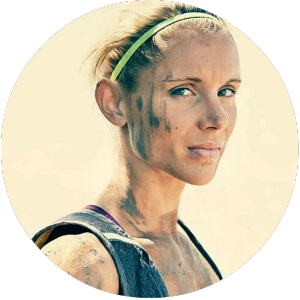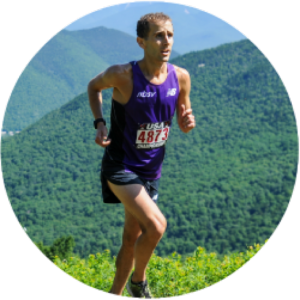Earlier this year, I worked with nearly a dozen professional runners to discover their injury prevention secrets.

Runners like Olympian Dathan Ritzenhein and 100k National Champion Devon Yanko.
Runners like World Mountain Running champion Joseph Gray and two-time winner of the World Warrior Dash Championships, Max King.
I put all of their suggestions, workouts, routines, and exercises into a book that you can download for free:
The Little Black Book of Prevention & Recovery
Learning from runners at the top of the sport has always been fascinating.
After all, why not learn from the best?
Today I’m highlighting the contributions from two elite athletes: a nationally ranked trail runner and one of the best Obstacle Course Racers in history.
If you can tease out just one lesson, you’ll benefit from it forever.
Use it to become a healthier, stronger, and more resilient runner. One who can handle more mileage, faster workouts, and speedier races.
Amelia Boone: “Mobility and Stability”
To prevent injury, I find there are two key parts: mobility and stability. Often athletes focus too much on one, and not enough on the other. A few things I do to address both parts:
Dedicate 10 minutes each night before you go to bed to mobilize a particular body part. It doesn’t need to be the same one (and shouldn’t always be the same!), but focus on moving your tissues and loosening up before you go to bed.
For runners, single leg strength is everything – I work on single leg stability at least twice a week in the form of lunges, single leg squats, balance work with slant boards, Bosu balls, and other unstable surfaces.
If you’ve injured a particular body part (i.e., muscle strain), focus on loosening the tissues around it – not the injured tissue itself.
For example, if you’ve pulled a hamstring, foam roll the calves, quads, glutes, etc. Those are the tissues that will compensate for the injury and lead to compensatory patterns. And often, the place of pain isn’t the source of the problem.
If you are desk bound like I am, do what you can to stay moving as much as possible. Take a lap around the office at least twice an hour.
On conference calls, I like to sit in the bottom of a squat or hold a plank. Keep a golf ball at your desk and roll out the bottom of your feet during the day. The little movements add up.
Go barefoot as much as possible in everyday life – builds foot strength, lets your toes breathe!
Take complete rest days – “active recovery” is all the rage right now, but I’m a firm believer in just letting the body be completely static once in a while. We can tend to take our “active recovery” too far!
About Amelia
 Amelia Boone is a force of nature. She’s not only a full-time attorney for Apple, but the most dominant female obstacle course athlete in history.
Amelia Boone is a force of nature. She’s not only a full-time attorney for Apple, but the most dominant female obstacle course athlete in history.
But she’s not just the best (if not THE best) female OCR athlete – she usually beats 99% of men in every race she enters.
A small taste of her racing performances include:
- 30+ victories (and 50+ podium finishes)
- 2013 Spartan Race World Champion
- 2012 Spartan Race World Championship 2nd place overall (only 8 minutes behind the male winner)
- 2012, 2014, and 2015 World’s Toughest Mudder Champion
- 3x finisher of the Death Race
Connect with Amelia: Follow her on Twitter, Instagram, or visit Amelia’s Website.
David Roche: “Adaptations are earned at the dinner table”
To have a long-term running career sustaining lots of miles, you need to be a champion eater.
I didn’t learn that tip in a book, but at a dinner table. In 2015, my wife and I were on the US Long Distance Mountain Running Team. The race went up to the saddle of the Matterhorn – in other words, it involved almost all uphill. I assumed that meant it was best to be skinny and light – after all, cyclist climbers usually have the body measurements of a praying mantis.
Then, I saw what happened at the dinner table. Some of the best mountain runners in the world ate and ate as if the big event was the Nathan’s Hot Dog Eating Contest, rather than an uphill race. One woman in particular packed olive oil in her carry-on just so she could have ready access. She got a plate of pasta, and glugged it out until what seemed like half the bottle was on the spaghetti.
Since then, I have done informal studies with the professional runners I coach. Without fail, the healthiest ones – the runners that win national championships year after year – eat plenty, always.
The mechanism at work is energy availability. Running burns lots of calories, and life burns lots too. Runners need to make sure they are never at a deficit when accounting for all of those demands on energy. A deficit for even one day during heavy training can increase injury risk. A longer-term deficit can have even more disastrous consequences on hormones.
Moreover, erring on the side of a surplus energy availability is helpful in spurring adaptations to heavy training, and it allows a runner to sustain harder work over time. Of course, runners can have success going the other way for a brief period. But the stories of talents lost to negative energy availability are too many to count.
So my main stay-healthy tip is to always eat enough. For a runner concerned about energy availability during hard training, no food is bad food. Scale your calorie intake to training levels (if you are running 15 miles per week, don’t eat like you are running 150), but never forget that your body needs fuel to stay healthy.
Training stimuli happen on the trails, roads or track; training adaptations are earned at the dinner table.
About David
David is the 2016 Way Too Cool 50k winner, the 2012 and 2014 USA Trail 10k National Champion, and the 2014 US Sub-Ultra Trail Runner of the Year.
He’s also a member of the 2014 US Mountain Running Team and 2015 US Long Distance Mountain Team.
He is also a columnist for Trail Running magazine and a public interest attorney focusing on environmental issues. A HOKA HOKA sponsored athlete, David is also a running coach.
Connect with David: Follow him on Twitter or check out his coaching site.
7 More Elites Share Their Top Recovery Strategies
The full book includes 7 more pro athletes:
- Dathan Ritzenhein – 3x Olympian, 3x National Cross Country Champion
- Kelly O’Mara – professional triathlete
- Ian Sharman – 3x winner of the Leadville Trail 100
- Devon Yanko – 100k National Champion and 2012 Olympic Trials Marathon Qualifier
- Joseph Gray – Mount Washington American Record holder and World Mountain Running Champion
- Andy Wacker – Trail Half Marathon National Champion
- Max King – US National Ultra Running Champion and 2x winner World Warrior Dash Champion
Their approaches to prevention, recovery, and resiliency are varied – and that’s why I love it!
Pick and choose the ideas that most resonate with you. Implement them and you’ll be a better, stronger, healthier, and faster runner.
Click on the button below to download the free book. Enjoy!
